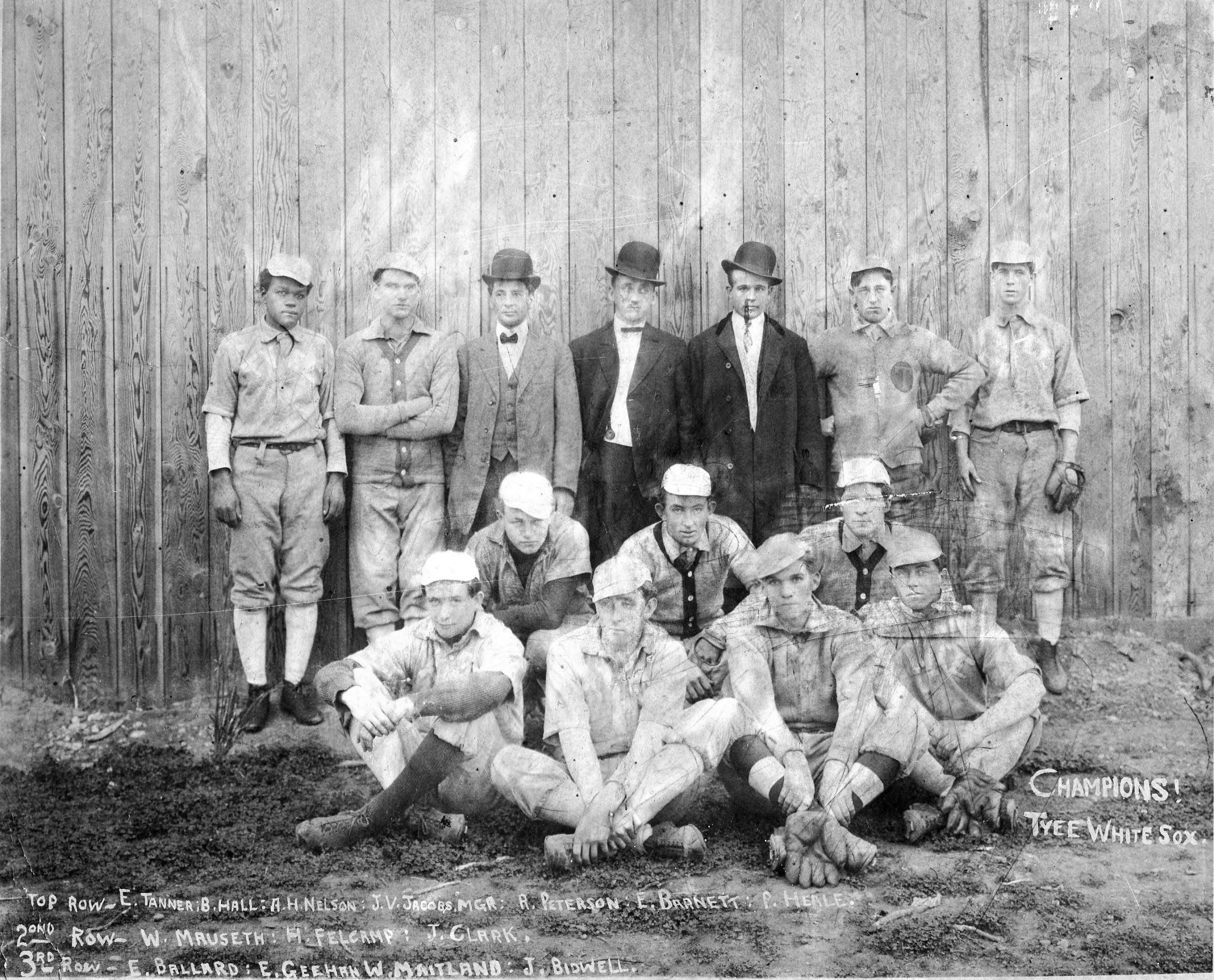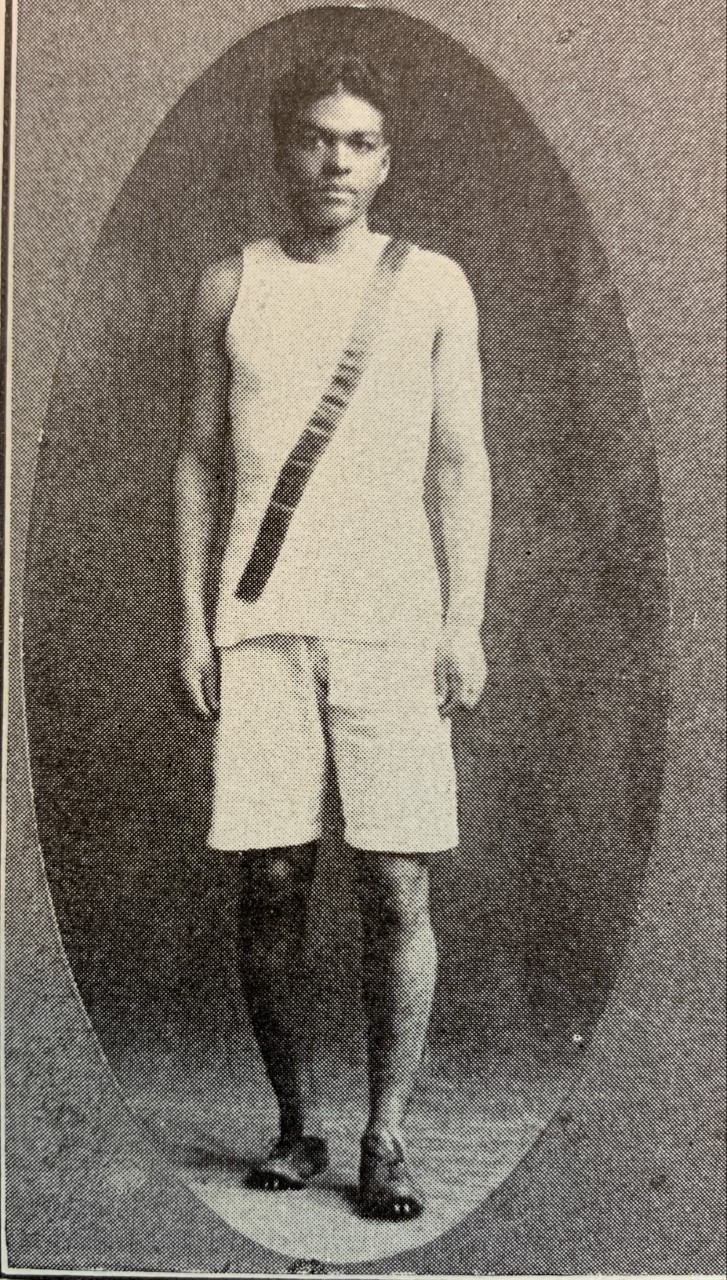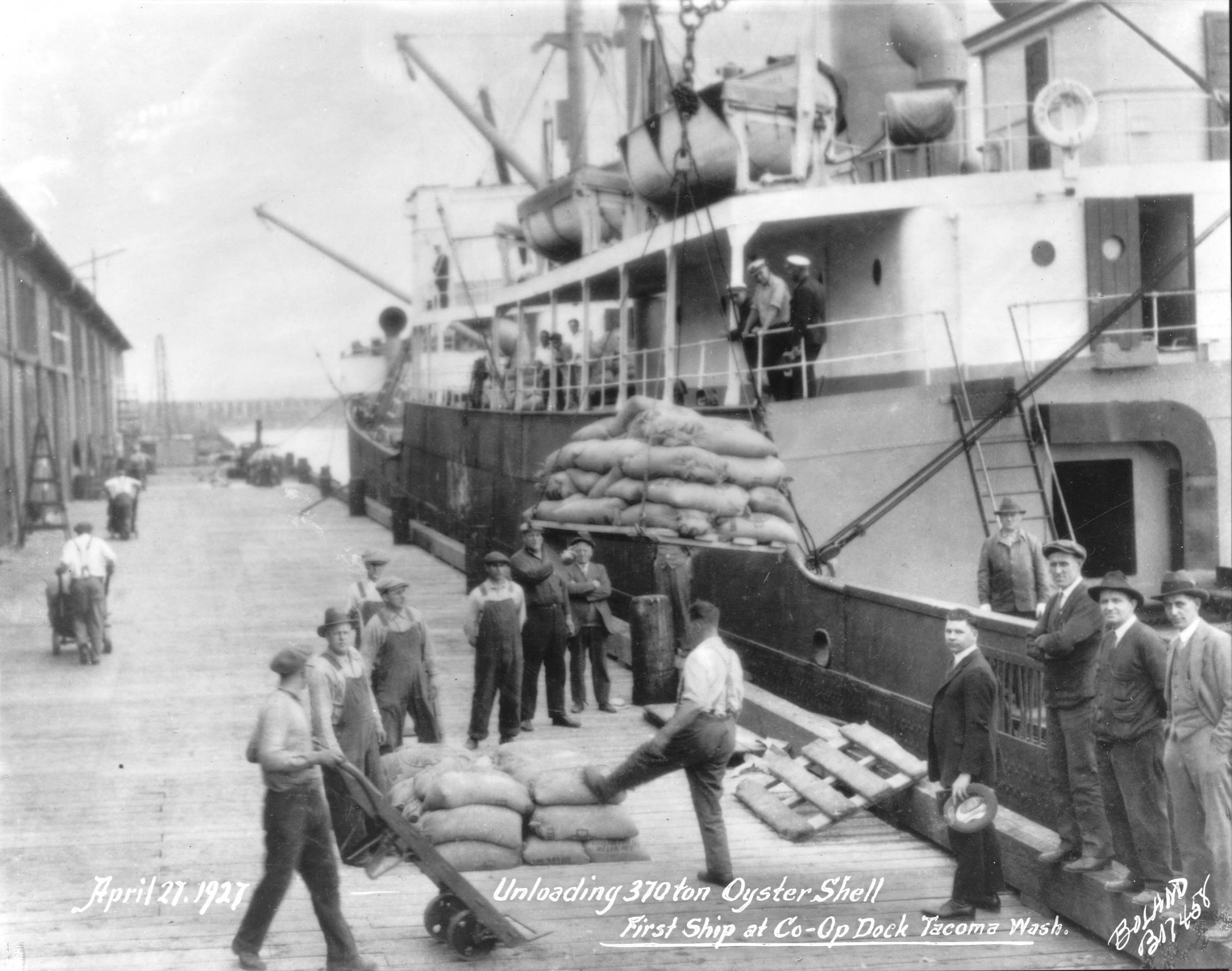By Spencer Bowman
While looking through the Northwest Room’s Image Archive for an April related photograph to feature in this Northwest Room Update, I stumbled on a fairly routine looking group shot of a baseball team. The photo was of the 1910 Tyee White Sox, a semi-professional team, who, according to the white writing on the right side of the photograph, won a championship that year. It wasn’t until I skimmed the caption and read the few sentences about the life of the team’s catcher, Ernest C. Tanner, did the photo really begin to become interesting. Ernie Tanner stands unassumingly in the far left of photo and seems to be the only Black player on the team.
Ernie Tanner was a student and athlete at Tacoma High School, now Stadium, where he was also on the track, football, and baseball teams. The Tacoma High’s June 1908 student monthly publication lists Tanner as the leader in runs, hits, and stolen bases that year. He was also an outstanding baseball catcher and outfielder. After graduating from Tacoma High in 1908, he attended Whitworth College, which was at that time located in North Tacoma, where he was the first Black quarterback in Washington state collegiate history! According to Ron Magden, a local Tacoma historian, Ernie Tanner was the last five-year high school sports letterman in Washington’s history (1).
After college he was both manager and catcher for the Tacoma Little Giants, a segregated independent baseball team. The Little Giants would play against a variety of other teams such as: the Center Street Sluggers, the Puyallup Firemen, and the Seattle Gophers, a Black team that included Charles Conna, son of early Black settler John Conna. The game summaries and scores in the papers, again and again mention Tanner as a major player for the Little Giants.
In January 1913, a committee began work to form a semi-professional Tacoma City Baseball League, however, late in this process, the Little Giants were excluded. Even though the Little Giants contributed funds early on to help form the league, they claimed they were being “frozen out". The Little Giants declared that they were entitled to recognition in the league just like the others, “If we were good enough to play last season with the teams now forming the league, we do not see why the bar should be raised this spring” (2). By February Joseph “Iron Man” McGinnty, the league organizer, specifically lobbied against the Little Giants along with the majority of the club owners. Because of this the Little Giants were dropped from the league. Amusingly, Joseph McGinnty’s baseball team, the Electrics, turned up playing against the Little Giants during spring training the following year. Reporting on one of the games, The Puyallup Valley Tribune wrote, “Ernie Tanner was the whole show for the colored boys as he went 4 for 5 at the plate with two stolen bases” (3).
The Little Giants continued to play independently for the next ten years and, according to author Ty Phelan, produced some of the best talent in the area, such as pitcher Jimmy Claxton. They would face many segregated teams from towns around the Pacific Northwest with significant Black populations. These included Spokane, Seattle, Yakima, Walla Walla, and Pasco, to name a few (4). In 1917 the Little Giants even competed in the “Colored Championship of the Northwest”. During his time on the team Tanner also worked as a Tacoma elevator operator but in 1918 he joined the Tacoma Chapter of the International Longshoreman’s Association.
At that time, racial discrimination was common and overt. Generally, Black union members were segregated and treated as "second class” (5). However, Tanner was integral in helping the longshoreman union during the 1934 “Big Strike” that shut down a majority ports along the West Coast. As the only Black member on the strike committee, he was instrumental in keeping both Black and White members united. From 1934-1936 Tanner rose in the ranks and once on the Local 38-97 union executive board he pressured leaders to pay Black dockworkers the same wages of their White counterparts. In 1950, Tanner was elected to be the chair to the new longshoreman building committee for the new union hall.
Ernest Charles Tanner passed away in 1956 at the age of 66. His obituary, printed on the sports page of the Tacoma News Tribune, included many heartfelt memories and accounts of his character and athletic prowess. “Over all the years, I would say that Tanner undoubtedly is the greatest all-around athlete that Tacoma high schools ever produced”, wrote Al Crain of the Tacoma News Tribune, “I am sure if it would not have been for the color barrier Ernie would have made the major leagues long before Jackie Robinson. He was faster and could hit more…he was the most powerful runner I ever saw” (6). Frank Cozza, who played with Ernest in high school remarked, “Ernie had all the mental and physical requirements of a great athlete, but the things I remember him best for were his terrific competitive spirit and his fine sense of sportsmanship”.
To learn more about Ernest Tanner and his impact in Tacoma’s history check out the resources below or contact us about more information on him, his life, and baseball history in the Pacific Northwest. The first two links direct you to our digitized clipping files that include newspaper articles on Tanner and baseball at the time. The second two links are two books that can circulate upon request. Just let us know you are interested! To make an appointment give us a call at (253) 280-2814 or visit this link.
-
-
-
-
-
-
-
-
-
-
-
-
-
-
-
- Tacoma - Biography A-Z - Tanner, Ernest
- Tacoma - Sports - Baseball - Thru 1939
- Darkhorse; The Jimmy Claxton Story by Ty Phelan
- Baseball In Tacoma-Pierce County by Marc H. Blau
- Playgrounds to the Pros; An Illustrated History of Sports in Tacoma-Pierce County by Caroline Denyer Gallacci, Marc H. Blau , and Doug McArthur
- Rain Check; Baseball in the Pacific Northwest by Mark L. Armour
-
-
-
-
-
-
-
-
-
-
-
-
-
-
- Sunday Afternoons at Garfield Park by Lyle Kenai Wilson, p.12
- Twilight League instead of city and suburban is Baseball Plan, TDL, 2/12/1913 p.9, Northwest Room Clipping Files
- Puyallup Valley Tribune, April 13th, 1914
- Ernie Tanner, Washington’s “Black Jim Thorpe”, by Ty Phelan, negroleaguehistory.com
- Ernest C. Tanner (1889-1956) by Dale Soden, BlackPast.org
- Sports Log (Ernest Tanner obituary) Tacoma News Tribune, May 20th, 1956, p.B5





